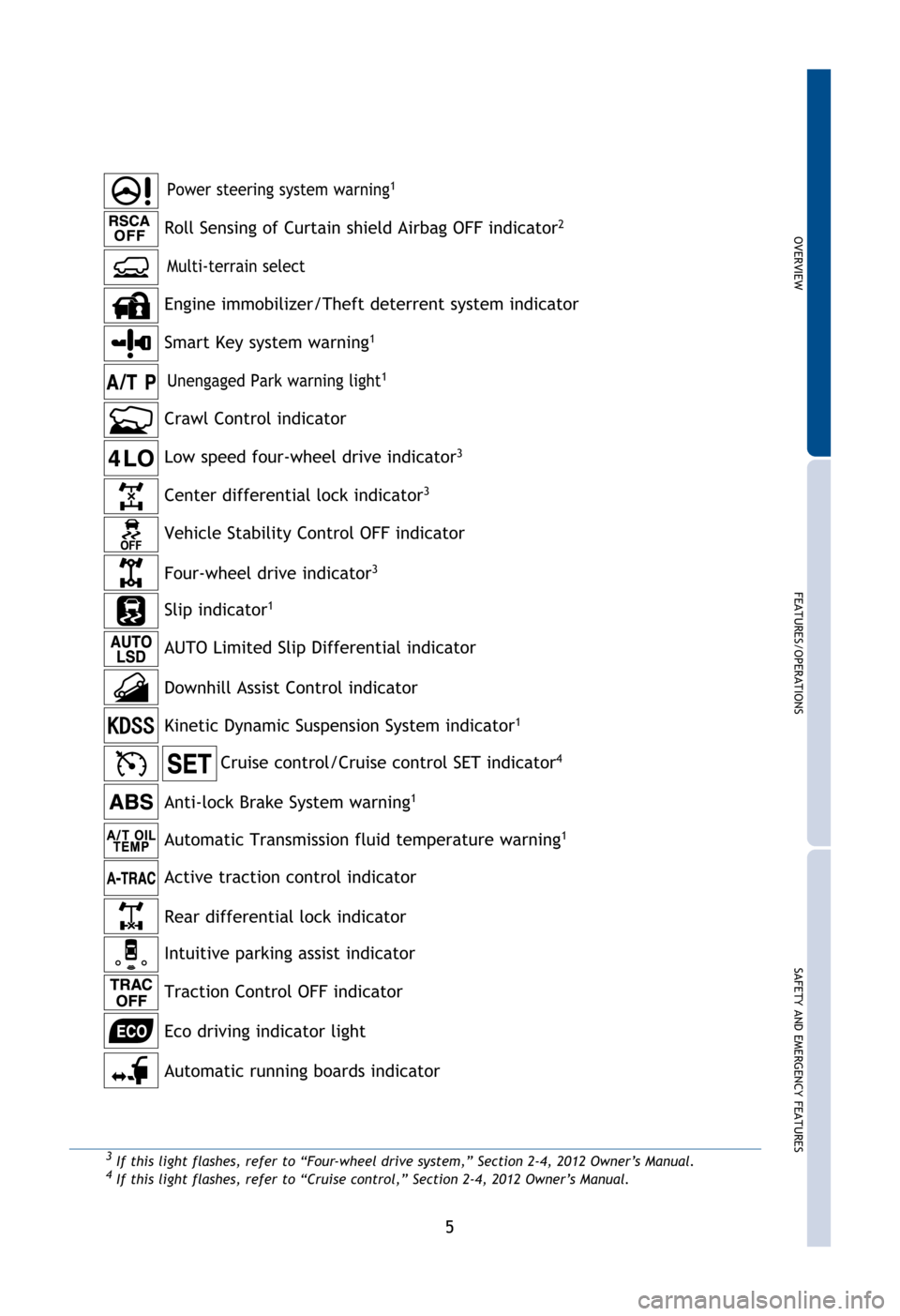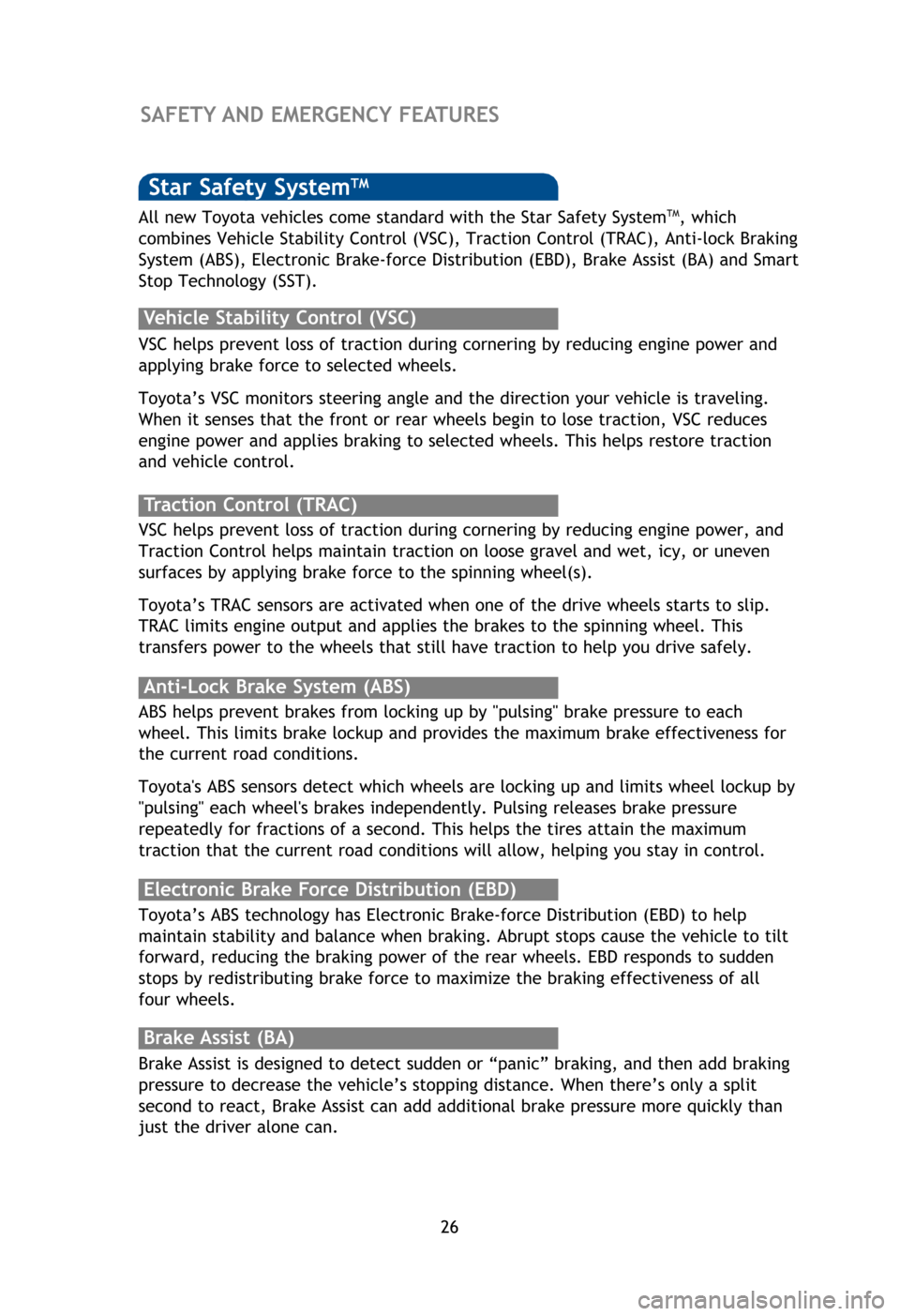traction control TOYOTA 4RUNNER 2012 N280 / 5.G Quick Reference Guide
[x] Cancel search | Manufacturer: TOYOTA, Model Year: 2012, Model line: 4RUNNER, Model: TOYOTA 4RUNNER 2012 N280 / 5.GPages: 32, PDF Size: 3.98 MB
Page 7 of 32

OVERVIEW
FEATURES/OPERATIONS
SAFETY AND EMERGENCY FEATURES
5
Automatic Transmission fluid temperature warning1
Crawl Control indicator
Four-wheel drive indicator3
Low speed four-wheel drive indicator3
Center differential lock indicator3
Slip indicator1
Vehicle Stability Control OFF indicator
Downhill Assist Control indicator AUTO Limited Slip Differential indicator
Cruise control/Cruise control SET indicator4
Roll Sensing of Curtain shield Airbag OFF indicator2
Engine immobilizer/Theft deterrent system indicator
Anti-lock Brake System warning
1
3If this light flashes, refer to “Four-wheel drive system,” Section 2-4, 2012 Owner’s Manual.4If this light flashes, refer to “Cruise control,” Section 2-4, 201\
2 Owner’s Manual.
Multi-terrain select
Rear differential lock indicator
Active traction control indicator
Power steering system warning1
Kinetic Dynamic Suspension System indicator1
Unengaged Park warning light1
Smart Key system warning1
Intuitive parking assist indicator
Eco driving indicator light Traction Control OFF indicator
Automatic running boards indicator
resize-20114Runner.qxd 10/6/11 12:11 AM Page 5
Page 28 of 32

26
SAFETY AND EMERGENCY FEATURES
Star Safety SystemTM
VSC helps prevent loss of traction during cornering by reducing engine p\
ower and
applying brake force to selected wheels.
Toyota’s VSC monitors steering angle and the direction your vehicle i\
s traveling.
When it senses that the front or rear wheels begin to lose traction, VSC\
reduces
engine power and applies braking to selected wheels. This helps restore \
traction
and vehicle control.
Vehicle Stability Control (VSC)
Anti-Lock Brake System (ABS)
Brake Assist (BA)
ABS helps prevent brakes from locking up by "pulsing" brake pressure to \
each
wheel. This limits brake lockup and provides the maximum brake effective\
ness for
the current road conditions.
Toyota's ABS sensors detect which wheels are locking up and limits wheel\
lockup by
"pulsing" each wheel's brakes independently. Pulsing releases brake pres\
sure
repeatedly for fractions of a second. This helps the tires attain the ma\
ximum
traction that the current road conditions will allow, helping you stay i\
n control.
Brake Assist is designed to detect sudden or “panic” braking, and \
then add braking
pressure to decrease the vehicle’s stopping distance. When there’s\
only a split
second to react, Brake Assist can add additional brake pressure more qui\
ckly than
just the driver alone can. VSC helps prevent loss of traction during cornering by reducing engine p\
ower, and
Traction Control helps maintain traction on loose gravel and wet, icy, o\
r uneven
surfaces by applying brake force to the spinning wheel(s).
Toyota’s TRAC sensors are activated when one of the drive wheels star\
ts to slip.
TRAC limits engine output and applies the brakes to the spinning wheel. \
This
transfers power to the wheels that still have traction to help you drive\
safely.
Traction Control (TRAC)
Electronic Brake Force Distribution (EBD)
Toyota’s ABS technology has Electronic Brake-force Distribution (EBD\
) to help
maintain stability and balance when braking. Abrupt stops cause the vehi\
cle to tilt
forward, reducing the braking power of the rear wheels. EBD responds to \
sudden
stops by redistributing brake force to maximize the braking effectivenes\
s of all
four wheels. All new Toyota vehicles come standard with the Star Safety System
TM, which
combines Vehicle Stability Control (VSC), Traction Control (TRAC), A\
nti-lock Braking
System (ABS), Electronic Brake-force Distribution (EBD), Brake Assis\
t (BA) and Smart
Stop Technology (SST).
resize-20114Runner.qxd 10/6/11 12:29 AM Page 26